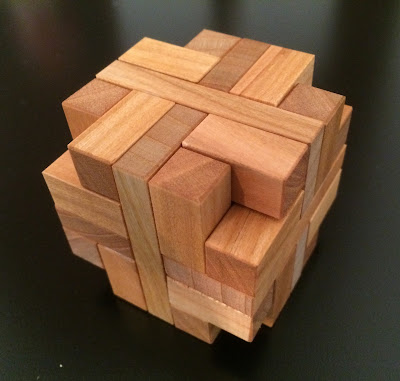This post is long overdue. In fact it is a year overdue. I received the Portico J as a Christmas present from Pelikan Puzzles of the Czech Republic during last Christmas in 2015. Portico J was designed by Stephane Chomine, who (at the time of this posting) has just done over 500 designs on PWBP.
I had played with Portico J for a while, found it a tad too difficult and put it away telling myself that I would come back to it sometime in early 2016...and promptly forgot about it for the next 12 months.
But over the last couple of days after some much required puzzle closet spring cleaning, out appears the Portico J and I decided to give it a go again. But before that, here are the stats; Portico J measures about 10cm x 5.5cm x 4.5cm. Consisting of an inverted T-shaped support with 3 traditional burr pieces and 2 board ones, it is an unusual shaped and looking interlocking puzzle. I figure this sort of shape may not appeal to everyone, but hey, there are loads of cubes and rectangles about so this is nice change. And I certainly quite like it. Comprising of Wenge and Cherry woods, it's impeccably made by the Pelikan Workshop. Everything slides and moves smoothly.
It took me a couple of hours spread over several sessions before I finally managed to remove the first piece. It has a level 20 solution and while the movable pieces can move only in certain directions within limits, it's a much harder puzzle to take apart than the shape (or the few number of pieces) would suggest. My early attempts were met with dead ends and when I finally got the first piece out, the process rather surprising, something I did not expect. After that, a bit more puzzling was still needed before the rest of the pieces were disentangled. Full take apart requires 35 moves.
As with such puzzles I needed Burr Tools to help with the re-assembly before everything was back to original. Can't do by memory here unfortunately!
The Portico J is very tricky right from the start and although not a very high level burr on paper, still it makes for a very challenging solve indeed. Oh, and there is a 5-piece Little Portico around too!
















































